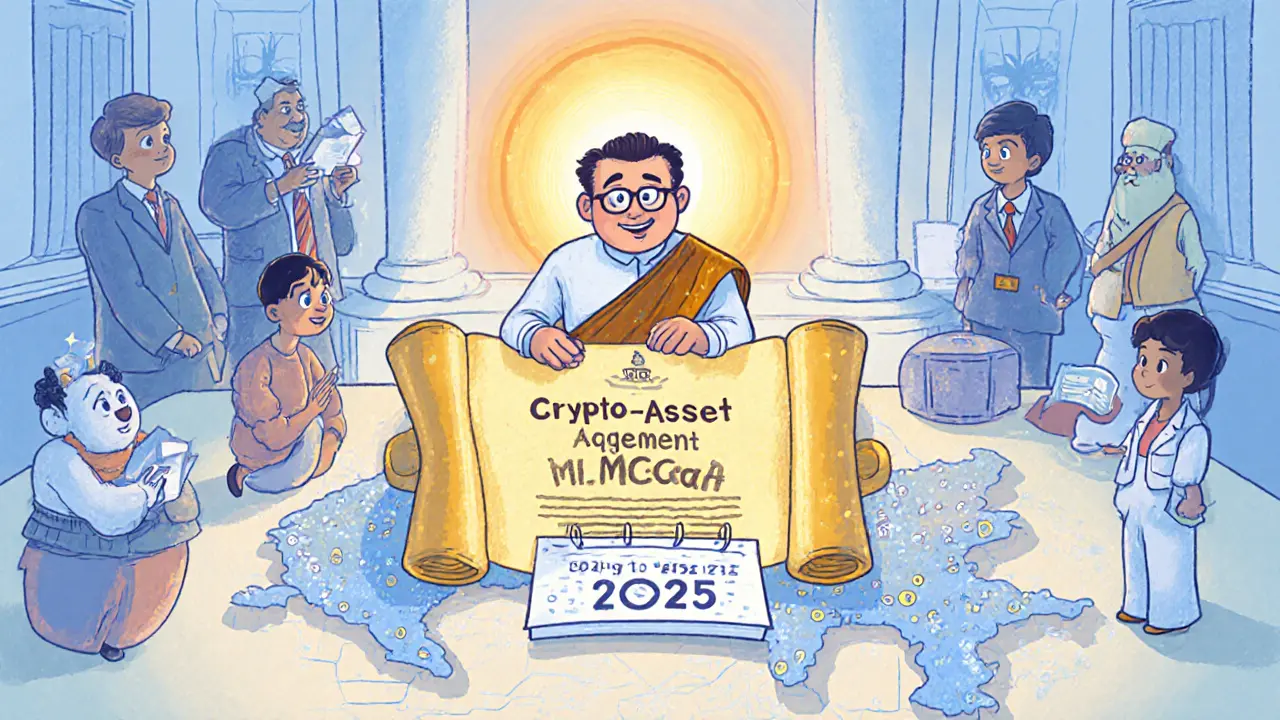India's CARF Implementation Timeline
Key Milestones in India's CARF Adoption
2025 - Signing of Crypto-Asset MCAA
India will sign a dedicated Multilateral Competent Authority Agreement (MCAA) for crypto assets, separate from the 2015 CRS agreement.
April 1, 2026 - Legal Trigger
Section 285BAA of the Income Tax Act becomes effective, obligating reporting entities to collect crypto-transaction data.
January 1, 2026 - Data Collection Ready
Reporting entities must be ready to receive and process data in the OECD-published XML format.
April 1, 2027 - Full CARF Exchange Begins
India fully participates in the global CARF exchange, reporting offshore crypto holdings automatically.
Participation: India joins 52 'relevant jurisdictions' committed to CARF by 2027.
G20 Support: CARF is endorsed in the G20 Leaders’ Declaration on crypto-tax transparency.
Timeline Advantage: India’s implementation timeline is relatively aggressive compared to peer countries.
- XML reporting standards
- New data-collection systems
- Staff training programs
- Integration with existing AML/KYC platforms
| Milestone | India | Global Avg. (2027-2028) |
|---|---|---|
| Sign Crypto-Asset MCAA | 2025 (planned) | 2025-2026 |
| Legal Trigger (Section 285BAA) | 1 Apr 2026 | 2026-2027 |
| Data Collection Ready | 1 Jan 2026 | 2026-2027 |
| Full CARF Exchange | 1 Apr 2027 | 2027-2028 |
Important Notes
- Entities have a 12-month window between legal trigger and full exchange to prepare systems and staff.
- Compliance requires integration with XML reporting standards and secure data transfer pipelines.
- Individual investors should ensure KYC records include all wallet addresses to avoid penalties.
The OECD Crypto-Asset Reporting Framework is set to reshape India’s crypto tax landscape, bringing offshore digital‑asset holdings under automatic information exchange. Here’s what you need to know about the timeline, legal steps, technical hurdles, and what it means for Indian users and businesses.
Quick Take
- India will start reporting crypto‑asset data under CARF from April12027.
- Section285BAA of the Income Tax Act, slated for April12026, mandates reporting by crypto service providers.
- A separate MCAA for crypto assets is expected to be signed in 2025.
- Compliance will require XML reporting, new data‑collection systems, and staff training.
- India joins 52 ‘relevant jurisdictions’ and supports the G20 push for global crypto tax transparency.
What is the OECD Crypto-Asset Reporting Framework?
When the OECD Crypto-Asset Reporting Framework is a global standard that extends the Automatic Exchange of Information (AEOI) to crypto‑assets, it enables tax authorities to share data on offshore digital holdings, tax evasion opportunities shrink dramatically. Developed jointly by the OECD and G20 finance ministers, CARF mirrors the Common Reporting Standard (CRS) that India has used since signing the Multilateral Competent Authority Agreement (MCAA) in 2015 for traditional financial accounts.
India’s Commitment and Timeline
India announced its intention to adopt CARF on 2September2024, with implementation kicking off on 1April2027. The rollout follows a clear sequence:
- 2025 - signing a dedicated crypto‑asset MCAA separate from the 2015 CRS agreement.
- 1April2026 - Section285BAA of the Income Tax Act becomes effective, obligating reporting entities to collect crypto‑transaction data.
- 1January2026 - reporting entities must be ready to receive and process data in the OECD‑published XML format.
- 1April2027 - full participation in the global CARF exchange begins.
This 12‑month window between the legal trigger (2026) and full exchange (2027) gives banks, crypto exchanges, and fintech firms time to upgrade systems and train staff.
Legislative Foundations: Finance Bill 2025 and Section285BAA
The Finance Bill 2025 introduces Section285BAA into the Income Tax Act, specifically targeting crypto‑asset transactions for reporting. Once in force, designated reporting entities - including banks, custodians, and crypto‑exchange platforms - must submit detailed information on:
- Account holder identity (PAN, jurisdiction of tax residence).
- Type of crypto‑asset (e.g., Bitcoin, Ethereum, stablecoins).
- Balance at year‑end and transaction totals.
- Counter‑party jurisdictions for cross‑border moves.
The law aligns India’s domestic framework with the international CARF model, ensuring that offshore holdings cannot hide from the tax net.
Technical Implementation: MCAA, XML Standards, and Reporting Infrastructure
Signing the crypto‑specific Multilateral Competent Authority Agreement (MCAA) creates the legal conduit for India to exchange crypto‑asset data with other jurisdictions is a prerequisite for participation. The OECD released an XML User Guide in October2024 that defines the data schema - fields such as CryptoAssetIdentifier, BalanceAmount, and TransactionDate are mandatory.
Key technical steps for Indian entities include:
- Integrating XML generation modules into existing AML/KYC platforms.
- Building secure data‑transfer pipelines to the Indian tax authority’s gateway.
- Testing end‑to‑end data exchange with OECD sandbox environments.
- Rolling out staff certification programs on CARF reporting requirements.

Impact on Taxpayers, Exchanges, and the Crypto Ecosystem
For the estimated 100million Indian crypto users, CARF translates into greater transparency. Tax professionals expect a noticeable lift in disclosed crypto income, similar to the 30% increase in CRS‑related disclosures after 2015.
Crypto exchanges - both domestic giants and smaller niche platforms - face a dual challenge:
- Compliance costs: system upgrades, third‑party compliance solutions, and ongoing reporting fees.
- Operational complexity: mapping on‑chain transactions to the XML schema, especially for decentralized finance (DeFi) protocols.
While larger exchanges may absorb these costs over 12‑18months, smaller players could seek outsourced compliance services or risk penalties for non‑submission.
Challenges and Mitigation Strategies
Implementation hurdles are real:
- Data granularity - on‑chain data is pseudonymous, requiring robust KYC linkage.
- Cross‑border tracking - users often move assets through mixers or foreign wallets, complicating jurisdiction identification.
- Technical readiness - legacy banking systems may lack APIs for XML generation.
Industry observers suggest three practical mitigations:
- Adopt standardized KYC onboarding that captures wallet addresses at the source.
- Leverage blockchain analytics tools (e.g., chainalysis, CipherTrace) to map on‑chain flows to customer profiles.
- Collaborate with the tax authority’s pilot program to test data exchange before the 2026 deadline.
India in the Global CARF Landscape
India’s adoption places it among 52 “relevant jurisdictions” committed to CARF by 2027, part of a broader coalition of 67 jurisdictions targeting 2027‑2028 rollout. The G20 has endorsed CARF as a cornerstone of its Leaders’ Declaration on crypto‑tax transparency, with the New Delhi Presidency championing swift implementation.
Compared with peers, India’s timeline is relatively aggressive. The United States is still drafting broker‑reporting rules, while the EU’s MiCA framework focuses on market regulation rather than tax exchange. This gives India a strategic advantage: early compliance can attract institutional investors seeking regulatory clarity.
Key Milestones - India vs. Global Average
| Milestone | India | Global Avg. (2027‑2028) |
|---|---|---|
| Sign Crypto‑Asset MCAA | 2025 (planned) | 2025‑2026 |
| Legal Trigger (Section285BAA) | 1Apr2026 | 2026‑2027 |
| Data Collection Ready | 1Jan2026 | 2026‑2027 |
| Full CARF Exchange | 1Apr2027 | 2027‑2028 |
What to Watch in 2025‑2027
Stay tuned for these developments:
- Final wording of Section285BAA - details on penalties and exemption thresholds.
- Release of the Indian Tax Authority’s XML validation toolkit (expected Q22025).
- Public‑private working groups between the Ministry of Finance and major crypto exchanges.
- Feedback from the Global Forum’s CARF Group on cross‑border data quality.
Being proactive now can smooth the transition when the reporting clock starts ticking.
Next Steps for Stakeholders
For crypto exchanges: Begin mapping existing transaction logs to the OECD XML schema, and allocate budget for compliance software.
For tax advisors and accountants: Update client checklists to include PAN‑linked crypto wallet details and prepare for joint audits using CARF data.
For individual investors: Ensure your KYC records include all wallet addresses; consider consolidating holdings to simplify reporting.

Frequently Asked Questions
What is the OECD Crypto-Asset Reporting Framework?
CARF is an international standard that extends the automatic exchange of tax information to crypto‑assets. It requires participating jurisdictions to collect and share data on offshore cryptocurrency holdings of tax residents.
When will India start reporting crypto data under CARF?
Full participation begins on 1April2027. The legal trigger, Section285BAA, becomes effective on 1April2026, giving entities a year to prepare.
Which entities must report under Section285BAA?
Designated reporting entities include banks, custodians, crypto‑exchange platforms, and any financial institution that facilitates crypto‑asset transactions for Indian residents.
What data format will be used for reporting?
The OECD mandates an XML schema published in October2024. Fields cover asset identifiers, balances, transaction totals, and holder tax residency.
How will CARF affect individual crypto investors in India?
Investors must ensure their KYC information includes all wallet addresses. Undeclared offshore holdings may be flagged, leading to tax assessments and penalties.


Comments
Rajini N
The roadmap lays out a clear path for India’s CARF rollout, starting with the MCAA signing in 2025 and culminating in full data exchange by April 2027. It’s helpful to note the legal trigger in April 2026 gives entities a full year to align their systems. Entities should focus on building XML reporting capabilities now, as the OECD schema is quite strict. Training staff early on will smooth the transition and avoid last‑minute rushes. Overall, the timeline is aggressive but achievable with proper planning.
April 7, 2025 AT 11:52
Sidharth Praveen
The 12‑month window is tight but doable.
April 9, 2025 AT 13:52
Sophie Sturdevant
From a compliance‑engineer perspective, the OECD CARF specification introduces a myriad of new data elements that will fundamentally reshape reporting architectures. First, the CryptoAssetIdentifier field mandates a globally unique token reference, which forces platforms to integrate with on‑chain indexing services such as Chainalysis or Covalent. Second, the BalanceAmount attribute must be reported in both native and fiat equivalents, requiring real‑time price feeds to avoid valuation disputes. Third, the TransactionDate element must capture the exact block timestamp, not just the settlement date, increasing granularity to the second. Fourth, the schema enforces jurisdiction codes for both the sender and receiver, demanding automated geo‑IP and KYC linkage pipelines. Fifth, the required XML namespace adheres to strict XSD validation, meaning any deviation will cause outright rejection by the tax authority’s gateway. Sixth, the reporting frequency shifts from annual to semi‑annual for high‑volume entities, adding operational overhead. Seventh, the integration with existing AML/KYC platforms must respect both legacy banking APIs and modern blockchain wallets, a non‑trivial interoperability challenge. Eighth, the anticipated penalties for non‑compliance are tiered, starting at 2% of reported turnover and scaling up to 10% for repeated failures, underscoring the risk exposure. Ninth, the data security requirements now incorporate end‑to‑end encryption and hardware security module (HSM) signing of each XML payload, raising the bar for IT security teams. Tenth, the tax authority will provide a sandbox environment for test submissions, but only limited slots are available, so early enrollment is crucial. Eleventh, the reporting entities will need to maintain an audit trail of any data transformations applied before submission, which adds to documentation burdens. Twelfth, the requirement to include wallet addresses in PAN‑linked records forces a tightening of KYC workflows, potentially impacting user onboarding times. Thirteenth, cross‑border data exchanges will be subject to mutual legal assistance treaty (MLAT) constraints, introducing a diplomatic dimension to technical compliance. Fourteenth, the OECD is planning a phased rollout of additional asset classes, such as tokenised securities, which means the current implementation should be future‑proofed. Finally, the overall ecosystem impact is likely to increase transparency dramatically, shrinking the shadow crypto economy and aligning India with global tax standards, which could attract more institutional capital seeking regulatory certainty.
April 11, 2025 AT 15:52
Nathan Blades
What a roller‑coaster! The depth of detail is staggering, and the stakes are sky‑high. Yet, imagine the confidence investors will feel when the framework finally clicks into place-like a symphony finally finding its crescendo. The drama of compliance meets the poetry of policy.
April 13, 2025 AT 17:52
Somesh Nikam
Hey folks, just wanted to add a quick heads‑up 🙂. If you’re running a crypto exchange, start mapping your transaction logs to the XML schema today. It’ll save you a ton of late‑night debugging later. Also, make sure your KYC forms ask for every wallet address-don’t leave any stone unturned. And remember, the tax authority will roll out a validation toolkit in Q2‑2025, so get familiar with it early. Good luck!
April 15, 2025 AT 19:52
Jan B.
XML schema is strict; validate early. Keep docs tidy.
April 17, 2025 AT 21:52
MARLIN RIVERA
This whole CARF push is just a bureaucratic nightmare. The government keeps adding layers of paperwork while the real issue-privacy-gets ignored. They'll drown small players in compliance costs and then brag about transparency. Typical.
April 19, 2025 AT 23:52
Debby Haime
Don't let the red tape discourage you! Every challenge is an opportunity to level up your tech stack. With the right tools, compliance can become a competitive advantage.
April 22, 2025 AT 01:52
emmanuel omari
India must show leadership, not just follow the West. Our crypto community is robust, and we shouldn't be forced into a foreign‑crafted framework that doesn't respect our sovereignty. The technical demands are massive, and it's a hidden way to control capital.
April 24, 2025 AT 03:52
Andy Cox
interesting take the timeline is tight but doable i think some flexibility will help
April 26, 2025 AT 05:52
Courtney Winq-Microblading
When we contemplate the philosophical implications of a global crypto‑asset reporting regime, we confront the dialectic between transparency and autonomy. The OECD's CARF is not merely a regulatory edict; it is a manifestation of the modern state's desire to map the once‑shadowy ledger of digital assets onto the palpable reality of fiscal responsibility. In doing so, it challenges the anarchic ethos that birthed cryptocurrencies while simultaneously offering a pathway toward legitimacy. The tension is palpable, yet the horizon gleams with the promise of harmonized data flows and reduced evasion. As we navigate this terrain, we must balance the insurgent spirit of innovation with the pragmatic need for order.
April 28, 2025 AT 07:52
katie littlewood
Alright, let’s break this down step by step. First, the 2025 MCAA signing is the foundation; without that legal conduit, nothing else moves. Second, the April 2026 legal trigger means every crypto‑exchange will need to start gathering data now, not later. Third, the January 2026 data‑collection readiness deadline is a hard stop-you’ll need your XML generators in place before the new year. Fourth, the 12‑month window between trigger and full exchange isn’t just a grace period; it’s a testing phase, so use it wisely to iron out kinks. Fifth, staff training can’t be an afterthought; the nuances of the schema require specialized knowledge. Sixth, integrating with AML/KYC platforms will demand API development, which can be a bottleneck if you’re still on legacy systems. Seventh, the penalties for non‑compliance are steep, so the risk management team should treat this as a top priority. Eighth, smaller firms might consider outsourcing compliance to avoid expensive in‑house development. Ninth, keep an eye on the upcoming XML validation toolkit from the tax authority-it’ll be essential for avoiding submission errors. Tenth, once the system is live, you’ll have the advantage of being part of a globally recognized framework, which could boost investor confidence. Lastly, remember that this is a moving target; stay updated on any amendments to the OECD guidelines to stay ahead of the curve.
April 30, 2025 AT 09:52
Jenae Lawler
Esteemed colleagues, I must interject with a measured observation concerning the foregoing exposition. While the delineated chronology is ostensibly comprehensive, one must inquire whether the authors have afforded sufficient deference to the sovereign prerogatives inherent in fiscal legislation. It would be prudent to await further juridical clarification before committing extensive resources to the prescribed schema, lest we precipitously embark upon an endeavour predicated upon provisional stipulations.
May 2, 2025 AT 11:52
Chad Fraser
Yo, the timeline looks intense but totally doable if we hustle now. Let’s get those XML pipelines up and start training the crew. We’ve got this!
May 4, 2025 AT 13:52
Jayne McCann
Honestly, I think this whole thing is overhyped. Simpler rules would work better.
May 6, 2025 AT 15:52
Richard Herman
Let’s keep the conversation constructive. The roadmap is ambitious, but with collaborative effort across exchanges, regulators, and tech providers, we can meet the deadlines without alienating any stakeholder.
May 8, 2025 AT 17:52
Parker Dixon
Exactly! 🤝 Cooperation is key, and we’ll likely see some cool open‑source tools emerge from the community. 🚀
May 10, 2025 AT 19:52
Stefano Benny
The framework is riddled with jargon and will simply add another compliance layer that benefits the bureaucrats more than the market. It’s a classic case of regulatory capture.
May 12, 2025 AT 21:52
Bobby Ferew
We’re all feeling the pressure, but let’s not forget the human side-people will have to juggle these new forms on top of their daily grind. It’s exhausting.
May 14, 2025 AT 23:52
celester Johnson
While the sentiment is understandable, the reality is that non‑compliance will incur substantial fines. Businesses must adapt or face severe consequences.
May 17, 2025 AT 01:52
Prince Chaudhary
Respectfully, I think the timeline is manageable if we respect each other’s constraints and keep communication channels open. Let’s support each other through this transition.
May 19, 2025 AT 03:52
John Kinh
meh, looks like a lot of hype. 🤷♂️
May 21, 2025 AT 05:52
Mark Camden
It is incumbent upon every institution to adopt rigorous compliance protocols as prescribed by the OECD CARF. Failure to do so would constitute a dereliction of fiduciary duty, undermining both tax equity and the rule of law.
May 23, 2025 AT 07:52
Evie View
Come on, calm down. The drama is unnecessary; just follow the rules and move on.
May 25, 2025 AT 09:52
Kate Roberge
Honestly, I think the whole CARF thing is a bit of a pretentious overreach. Simpler solutions could achieve the same transparency without all this bureaucracy.
May 27, 2025 AT 11:52